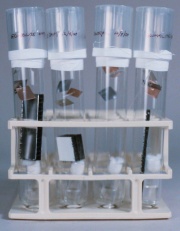Oddy test
Description
A low cost, non-specific test used to detect potentially hazardous gases emitted in a closed environment. The Oddy test was first suggested by Andrew Oddy, British Museum, in 1973. It involves placing clean metal coupons in a sealed container with the test material (wood, paint, adhesive, cloth, etc.). Optimal experimental conditions usually include exposing 2 grams of test material to at least two or three metals (lead, silver and copper) in a sealed glass flask for 4 weeks (28 days) at 60 degrees Celsius. The flask should also contain a cotton ball soaked with 2 ml deionized water as a source of humidity (Green and Thickett 1995). Following the test, the coupons are visually inspected for corrosion and tarnishing.
Synonyms and Related Terms
Oddy-Test (Deut.); test d'Oddy (Fr.); accelerated corrosion test
Sources for Additional Information
° L.R.Green, D.Thickett, "Testing Materials for Use in the Storage and Display of Antiquities. A Revised Methodology" Studies in Conservation, 40(3), 1995, p.145-152.
° W.A.Oddy, "An unsuspected danger in display", Museum Journal 73, 1973, p.27-28.
Other Sources checked for information
- Pam Hatchfield, Pollutants in the Museum Environment, Archetype Press, London, 2002.
